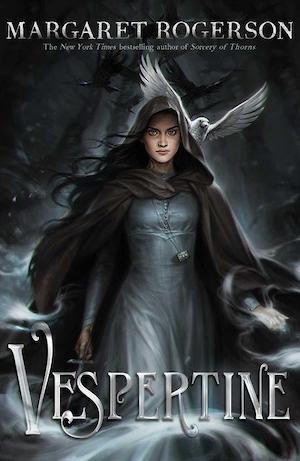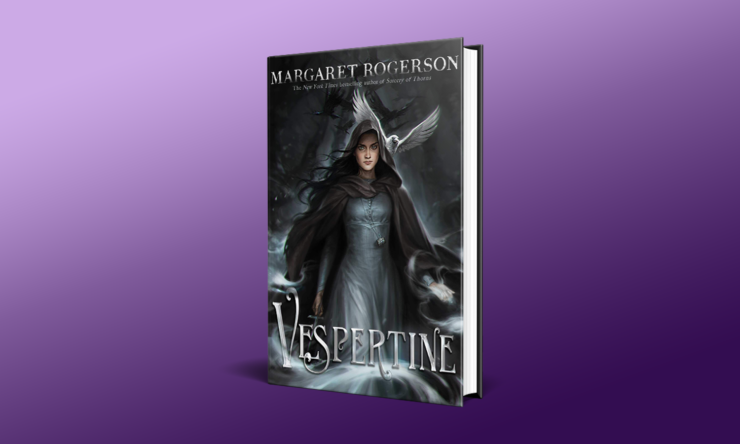Because of Vespertine, I finally watched Venom. I was halfway through the novel when I saw that Margaret Rogerson (An Enchantment of Ravens) had described her new YA fantasy as “medieval Venom starring a nun and a ghost,” and naturally I needed the full context for this darkly charming comparison.
This description is not wrong. But unlike Eddie Brock, Artemisia of Naimes isn’t a hot mess before she meets the being that takes up residence in her body. She’s a teenage girl with the Sight, the ability to see spirits, which no longer pass on to death without help. She wants nothing more than to stay in Naimes, working as a Grey Sister, socializing as little as possible, spending her time dealing with the dead.
Fate—or the Lady—has other plans.
Vespertine is dense and rich with lore, atmosphere, and the eerie details of a world full of spirits. Ages ago, the Raven King performed a massive and forbidden Old Magic ritual, and in the wake of that ritual, death is essentially broken. Untended souls return in forms both harmless and deadly, from shining wisps to vicious white vicars. The task of the Grey Sisters, and the rest of the Clerisy, is to deal with this reality. There are souls to put to rest, gaunts and furies and ashgrims to defeat, relics to guard, and an entire hierarchy of spirits to learn—none so terrifying as the Fifth Order spirits, the revenants. No one knows what creates them, and no one has faced one for quite some time.
The Clerisy is full of Grey Sisters and priests and abbots and confessors and, in the distant city of Bonsaint, the Divine, who rules over all. It’s a lot to keep track of, and though there’s a list of the orders of spirits at the back of my review copy, it’s tucked away after the story for a reason: it’s a tiny bit spoilery. Handy for remembering which kind of spirits is which, but possibly more than you want to know about the revenants, at least until you near the end.
Buy the Book


Vespertine
But though the details are complex and Rogerson’s setting fascinating (more than a bit, the world of Loraille suggests medieval France), it’s Artemisia that keeps this story moving. Possessed by an ashgrim (the spirit of someone killed by fire) as a baby, she spent much of her childhood locked in a shed until she figured out how to drive the spirit from her body. The result left her scarred but free—and traumatized. There’s so much she just didn’t learn, and so much she finds understandably difficult. People are difficult. Doing what’s expected is difficult. Doing the right thing with her face is difficult. And when she touches the relic of Saint Eugenia and unexpectedly feels the presence of the revenant bound within, her life gets exponentially more complicated.
When possessed soldiers attack the convent, Artemisia winds up taking up the saint’s reliquary—which means allowing the revenant into her mind and body. Impatient, sarcastic, powerful, and maybe not entirely evil, the revenant is unlike anyone, or anything, else Artemisia has ever encountered. As promised, it’s a sort of medieval Venom with a very different perspective on Artemisia’s world. As they bond and begin to work together, their relationship leads Artemisia to question so much of what she’s been taught. What are the revenants? What does it do to a spirit to bind it in an object? Is the Lady a merciful deity?
As the pair makes their way across the countryside to Bonsaint, where hints of Old Magic swirl through the city and the Clerisy, people begin to see Artemisia as a saint, or at least a vespertine—the name for a nun who wields a powerful high relic. But how does a traumatized teenage girl reconcile her idea of saints with the reality of her existence? How does becoming a vespertine, a person almost out of legend, change how she views the stories she’s been told?
Vespertine hints at more twists and secrets than this single volume holds; there’s more to Old Magic, the Raven King, and the formation of the Clerisy, than Rogerson has yet revealed. There’s a whiff of Gideon the Ninth here, though Vespertine’s dead things are generally less bony (saint’s relics, though, are often body parts). The snarky revenant would probably befriend Gideon in a heartbeat. But the more direct ancestor to Vespertine is Garth Nix’s Sabriel, with its necromancer who sends unwilling spirits back into Death. Nix’s Old Kingdom is simpler, without Vespertine’s complex and fascinating religion, but Vespertine’s forbidden Old Magic has some parallels in Nix’s Free Magic, and the seven revenants to the seven bells wielded by Sabriel and other necromancers.
Artemisia herself has more in common with Nix’s poor Clariel, who just wanted to be left alone. (Her fate seems likely to be considerably less grim, though.) The challenges she faces aren’t just the magical kind. Being around people is hard for her; people having faith in her, and needing her, even more so. An unexpected friendship she eventually forms is a graceful reminder that everyone makes assumptions about others sometimes, and that getting past them can be deeply meaningful. And another traumatized character, the massive soldier Jean, helps Artemisia understand that while the horror of her childhood shaped her, it doesn’t define her. There are still so many choices she can make.
Artemisia’s quest becomes about saving her world, but also about finding deeper truths—the truth about Old Magic, the truth about the revenants (tantalizingly still unclear at the end); the truth about the world she knows and the role she wants to play in it. What will become of her faith—and her bond with the revenant—remains to be seen in the eventual second book in this duology. Like Venom, Vespertine cannot be contained in a single story.
Vespertine is published by Margaret K. McElderry Books.
Read an excerpt here.
Molly Templeton lives and writes in Oregon, and spends as much time as possible in the woods. Sometimes she talks about books on Twitter.










